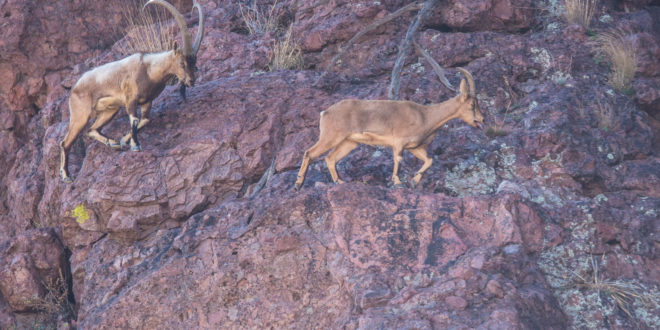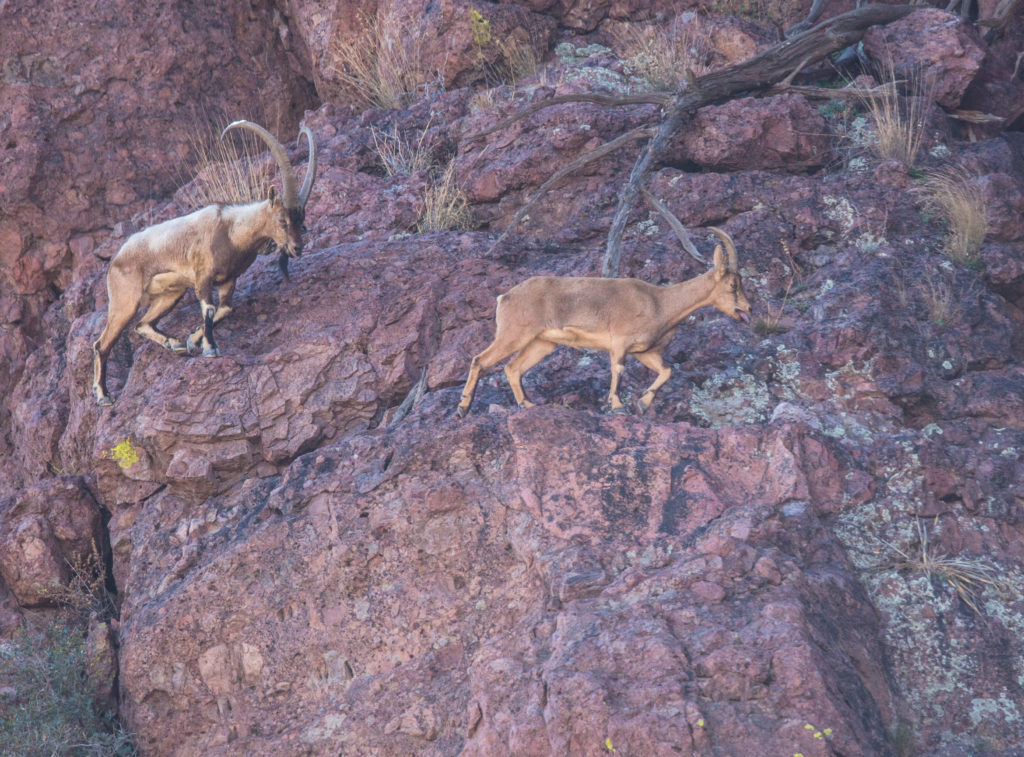Sometimes called bezoar goat or Persian wild goat, the short-legged Persian ibex is regarded as the ancestor of the domestic goat. Ibex stand approximately 30 inches at the shoulder, and the hind quarters are noticeably higher than the front when on flat ground. Adult males weigh up to 110 pounds, and females usually weigh up to 60 pounds. Both male and female ibex grow horns, with the females averaging up to 15 inches of horn growth. Males can grow scimitar-shaped horns longer than 50 inches. The light-brown ibex blend in with the surrounding terrain during summer. As winter approaches and the rut (breeding season) begins, mature males undergo a dramatic transformation. The color of the body turns almost white in color and hunters have given them the name “white billies.” Markings on the legs darken, and a black-brown cross forms over the shoulders and back. The billy’s face darkens, and the beard and tail turn jet black.
Spotting a Persian ibex can be a challenge. Stealth, camouflage and patience are required. Ibex have keen eyesight that enables them to notice movement more than half a mile away. Their specially adapted hooves have a soft inner pocket surrounded by a hard outer ring, allowing them to cling to rocky surfaces and traverse sheer cliffs. These attributes, combined with the ability to jump several times their own height, make hunting or spotting the Persian ibex extremely challenging but rewarding.
Persian ibex were introduced into the Florida Mountains near Deming in 1970, with the first hunt being offered in 1974. Recent aerial and ground survey data indicate the population has declined in the last few years. Based on this information, the New Mexico Department of Game and Fish (department) will be reducing overall ibex licenses beginning in the 2023-2024 season. Environmental conditions are great following a record monsoon season in summer 2022 and ibex are going into the winter in very good body condition. With above-average moisture this year, male ibex horn growth will be better than on average or drought years. Hunters should focus their harvest on mature males in the 35-40-inch range. Exceptionally large males are harvested that measure 40-45 inches, but are more rare and harder to find.
The recommended technique is to glass and move around the base of the mountain. Ibex typically do not move much during the night, allowing hunters to “roost” them in a similar manner to turkeys. Glassing them up in the evening until dark can help the hunter prepare for the following day’s hunt, knowing where they should begin their morning.
Ibex archery hunts are described as one of North America’s toughest hunts, with a success rate between 3 and 5%. However, hunters report the hunts to be very exciting and worthwhile. Muzzleloader hunters are reminded that beginning in the 2023-2024 season, only iron sights are allowed on muzzle-loading rifles during designated muzzleloader hunts. Scopes, red dots and all other optical sights are prohibited.
A once-in-a-lifetime, either-sex hunt is offered in mid-to-late November, allowing the hunter to take a large, mature billy. A once-in-a-youth hunt is offered during the December holiday school break, allowing youth the opportunity to hunt for ibex over the course of several days without missing school.
Female-immature male hunts allow the harvest of females and immature males with horns less than 20 inches in length, while helping NMDGF manage the ibex population within its specified goals and objectives.
 New Mexico Wildlife magazine Conserving New Mexico's Wildlife for Future Generations
New Mexico Wildlife magazine Conserving New Mexico's Wildlife for Future Generations


